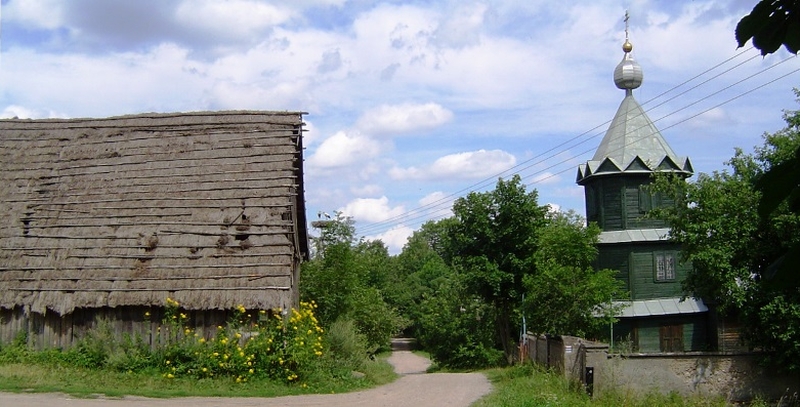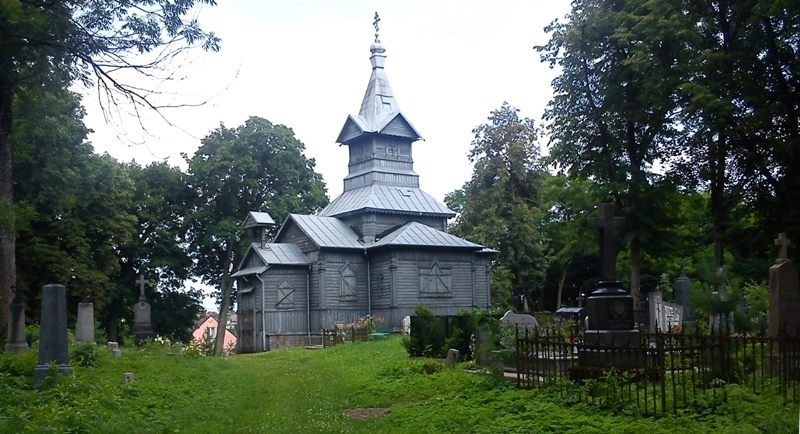rosyjska gwara Staroobrzędowców
Pokrewieństwo i tożsamość
języki indoeuropejskie → języki słowiańskie → języki wschodniosłowiańskie → język rosyjski(za: Lewis 2009
 Lewis 2009 / komentarz/comment/r /
Lewis 2009 / komentarz/comment/r / Lewis, Paul M. (red.) 2009. Ethnologue: Languages of the World. Dallas: Summer Institute of Linguistics.
 )
)Odmiany językowe używane przez Staroobrzędowców należą do gwar języka rosyjskiego typu pskowskiego. Pskowska grupa gwar należy do (tzw. akających) gwar środkowowielkoruskich części zachodniej (Grek-Pabisowa i Maryniakowa 1972: 114
 Grek-Pabisowa i Maryniakowa 1972 / komentarz/comment/r /
Grek-Pabisowa i Maryniakowa 1972 / komentarz/comment/r / Grek-Pabisowa Iryda & Irena Maryniakowa 1972. „Teksty gwarowe rosyjskie”, w: Antonina Obrębska-Jabłońska (red.) Teksty gwarowe z Białostocczyzny z komentarzem językowym. Warszawa: PWN, s. 113-131.
 ). W gwarach akających głoski [o] i [a] przed akcentem wymawia się tak samo.
). W gwarach akających głoski [o] i [a] przed akcentem wymawia się tak samo.Tożsamość
Tożsamość polskich Staroobrzędowców zasadza się na poczuciu odrębności religijnej i językowej; nie jest ważna dla nich świadomość odrębności etnicznej (Zielińska 1996: 45-46 Zielińska 1996 / komentarz/comment/r /
Zielińska 1996 / komentarz/comment/r / Zielińska, Anna 1996. Wielojęzyczność staroobrzędowców mieszkających w Polsce. Warszawa: Slawistyczny Ośrodek Wydawniczy.
 ). Skupia ich Staroprawosławna Cerkiew Pomorska Rzeczypospolitej Polskiej, która reprezentuje nurt bezpopowców (tj. nieposiadający hierarchii duchowej) w tradycji staroobrzędowej. Zasadniczo brak u nich silnej identyfikacji z Rosją i narodem rosyjskim. Istnieje natomiast poczucie więzi ze współwyznawcami z krajów bałtyckich (Zielińska 1996: 46
). Skupia ich Staroprawosławna Cerkiew Pomorska Rzeczypospolitej Polskiej, która reprezentuje nurt bezpopowców (tj. nieposiadający hierarchii duchowej) w tradycji staroobrzędowej. Zasadniczo brak u nich silnej identyfikacji z Rosją i narodem rosyjskim. Istnieje natomiast poczucie więzi ze współwyznawcami z krajów bałtyckich (Zielińska 1996: 46 Zielińska 1996 / komentarz/comment/r /
Zielińska 1996 / komentarz/comment/r / Zielińska, Anna 1996. Wielojęzyczność staroobrzędowców mieszkających w Polsce. Warszawa: Slawistyczny Ośrodek Wydawniczy.
 ).
).Staroobrzędowcy z Mazur mają (lub mieli w latach 1990-tych) poczucie przynależności do Niemiec i identyfikują się jako część niemieckiej mniejszości narodowej, wyróżniającą się religią (Zielińska 1996: 46
 Zielińska 1996 / komentarz/comment/r /
Zielińska 1996 / komentarz/comment/r / Zielińska, Anna 1996. Wielojęzyczność staroobrzędowców mieszkających w Polsce. Warszawa: Slawistyczny Ośrodek Wydawniczy.
 ). Staroobrzędowcy żyjący w Hamburgu utożsamiają się ze społecznością imigrantów z Prus Wschodnich, także z osobami innych wyznań (np. ewangelikami, prawosławnymi).
). Staroobrzędowcy żyjący w Hamburgu utożsamiają się ze społecznością imigrantów z Prus Wschodnich, także z osobami innych wyznań (np. ewangelikami, prawosławnymi).Na Mazurach mieszkają również jednowiercy, potomkowie staroobrzędowców, którzy przyłączyli się do Cerkwi prawosławnej głównego nurtu, zachowując jednak własną obrzędowość (Zielińska 1996: 30
 Zielińska 1996 / komentarz/comment/r /
Zielińska 1996 / komentarz/comment/r / Zielińska, Anna 1996. Wielojęzyczność staroobrzędowców mieszkających w Polsce. Warszawa: Slawistyczny Ośrodek Wydawniczy.
 ). Jednowierców władze rosyjskie osiedliły również na Suwalszczyźnie, licząc na przyłączenie Staroobrzędowców pod wpływem ich obecności do oficjalnego prawosławia. Jednowiercom nadano w 1842 r. folwark Karolin (gdzie założono wieś Pokrowsk) i obręb leśny Cieszkinie (Sosna i Troc-Sosna 2002: 139
). Jednowierców władze rosyjskie osiedliły również na Suwalszczyźnie, licząc na przyłączenie Staroobrzędowców pod wpływem ich obecności do oficjalnego prawosławia. Jednowiercom nadano w 1842 r. folwark Karolin (gdzie założono wieś Pokrowsk) i obręb leśny Cieszkinie (Sosna i Troc-Sosna 2002: 139 Sosna i Troc-Sosna 2002 / komentarz/comment/r /
Sosna i Troc-Sosna 2002 / komentarz/comment/r / Sosna, Grzegorz & Antonina Troc-Sosna 2002. Zapomniane dziedzictwo. Białystok: Orthdruk.
 ). Jeszcze w 1921 r. w powiecie sejneńskim jednowiercy przeważali liczebnie nad staroobrzędowcami i innymi prawosławnymi (Sosna i Troc-Sosna 2002: 142
). Jeszcze w 1921 r. w powiecie sejneńskim jednowiercy przeważali liczebnie nad staroobrzędowcami i innymi prawosławnymi (Sosna i Troc-Sosna 2002: 142 Sosna i Troc-Sosna 2002 / komentarz/comment/r /
Sosna i Troc-Sosna 2002 / komentarz/comment/r / Sosna, Grzegorz & Antonina Troc-Sosna 2002. Zapomniane dziedzictwo. Białystok: Orthdruk.
 ). Po II wojnie światowej prawie cała ludność rosyjska przeniosła się do ZSRR – w 1970 r. pozostawało jedynie kilkanaście rodzin Staroobrzędowców (Sosna i Troc-Sosna 2002: 142-143
). Po II wojnie światowej prawie cała ludność rosyjska przeniosła się do ZSRR – w 1970 r. pozostawało jedynie kilkanaście rodzin Staroobrzędowców (Sosna i Troc-Sosna 2002: 142-143 Sosna i Troc-Sosna 2002 / komentarz/comment/r /
Sosna i Troc-Sosna 2002 / komentarz/comment/r / Sosna, Grzegorz & Antonina Troc-Sosna 2002. Zapomniane dziedzictwo. Białystok: Orthdruk.
 ).
).O Rosjanach-staroobrzędowcach jako jednej z mniejszości religijnych w Polsce pisze wszechstronnie Rykała 2011
 Rykała 2011 / komentarz/comment/r /
Rykała 2011 / komentarz/comment/r / Rykała, Andrzej 2011. Mniejszości religijne w Polsce - geneza, struktury przestrzenne, tło etniczne. Łódź: Wydawnictwo Uniwersytetu Łódzkiego.
 .
.
Centrum wsi Wodziłki, fot. T. Wicherkiewicz.

Molenna cmentarna w Suwałkach, fot. A. Jorroch.
Kod ISO
| ISO 639-1 | ru |
| ISO 639-2 | rus |
| ISO 639-3 | rus |
| SIL | RUS |
- przyp01
- Zielińska 1999
- Wicherkiewicz 2000
- Crummey 1998
- Abramow i Abramowa 2009b
- Witkowski 2011
- Zalizniak 2004
- Grek-Pabisowa 1997
- Tetzner 1902
- Palikowa i Rostowa 2008
- Zielińska 1996
- Grek-Pabisowa i Maryniakowa 1972
- Sosna i Troc-Sosna 2002
- Kisin 2012
- Ledieniewa i Wojłowa [?]
- Gudaszewski i Chmielewski 2010
- Zielińska 1997
- Siatkowski 1983
- Głuszkowski 2011
- List of declarations 2012
- Abramow i Abramowa 2009a
- Grek-Pabisowa i Maryniakowa 1980
- Palikowa i Rownowa 2008
- Lewis 2009
- Rykała 2011
- zagrożenie języków / language endangerment
- Osady staroobrzędowców w Polsce
- Gramota na korze brzozowej
- Wsie Staroobrzędowców na Mazurach
- Półustaw - krój pisma cyrylicznego
- Wczesny tekst cyryliczny wydrukowany grażdanką
- Liczba osób wyznania staroobrzędowego
- Okładka słownika gwary polskich Staroobrzędowców
- Słownik dialektu Staroobrzędowców Estonii
- Tekst modlitwy 'Ojcze nasz'
- Tablica na Naczelnej Rady Staroobrzędowców
- Tablica informacyjna na molennie w Suwałkach
- Panorama Wodziłek
- Starowierki (z Łotwy) w tradycyjnych strojach
- Centrum wsi Wodziłki
- Księga liturgiczna Staroobrzedowców z Wojnowa
- Molenna w Gabowych Grądach
- Tradycyjny strój Starowierki
- Wiejska bania w Wodziłkach
- Współczesny nagrobek Staroobrzędowców w Wodziłkach
- Księga liturgiczna i modlitewne czotki
- Była molenna Staroobrzędowców w Gibach
- Molenna cmentarna w Suwałkach